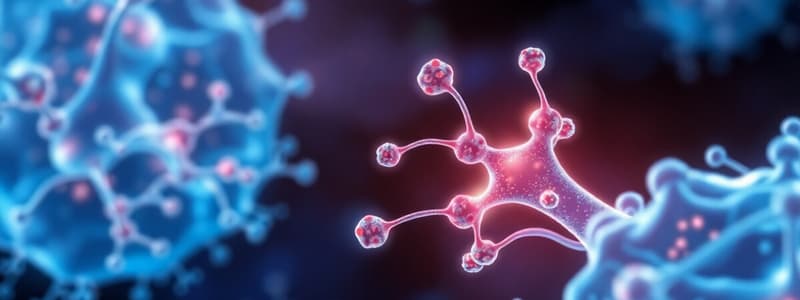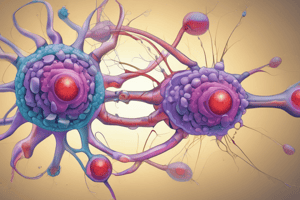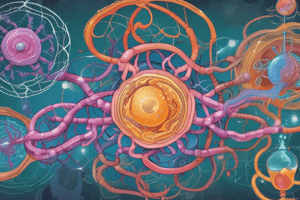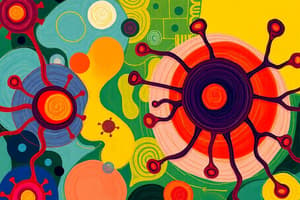Podcast
Questions and Answers
What is the first step in the process of cell signaling?
What is the first step in the process of cell signaling?
- Respond to signal
- Transduce the signal
- Receive the signal (correct)
- Convert the signal to intracellular info
Which type of signaling involves cells communicating over short distances using secreted messenger molecules?
Which type of signaling involves cells communicating over short distances using secreted messenger molecules?
- Paracrine signaling (correct)
- Juxtracrine signaling
- Autocrine signaling
- Endocrine signaling
What type of receptors can trigger multiple signal transduction pathways at once?
What type of receptors can trigger multiple signal transduction pathways at once?
- Intracellular receptors
- G protein-coupled receptors
- Ion channel receptors
- Receptor tyrosine kinases (correct)
Which process describes signaling between the same cell?
Which process describes signaling between the same cell?
What is a defining feature of G protein-coupled receptors?
What is a defining feature of G protein-coupled receptors?
What is required for a cell to respond to a specific signal?
What is required for a cell to respond to a specific signal?
Which of the following is NOT a type of membrane receptor?
Which of the following is NOT a type of membrane receptor?
What does cortisol primarily aid in regarding metabolism?
What does cortisol primarily aid in regarding metabolism?
What is the primary role of a kinase enzyme in cell signaling?
What is the primary role of a kinase enzyme in cell signaling?
What happens when a ligand binds to a ligand-gated ion channel?
What happens when a ligand binds to a ligand-gated ion channel?
How do intracellular receptors operate when activated by small hydrophobic chemical messengers?
How do intracellular receptors operate when activated by small hydrophobic chemical messengers?
In signal transduction, what is the significance of protein phosphorylation?
In signal transduction, what is the significance of protein phosphorylation?
Which of the following is NOT a common second messenger in signaling pathways?
Which of the following is NOT a common second messenger in signaling pathways?
What initiates the activation of protein kinase A (PKA) in a signaling pathway involving cyclic AMP?
What initiates the activation of protein kinase A (PKA) in a signaling pathway involving cyclic AMP?
What is the primary consequence of increased calcium ion concentrations in animal cells?
What is the primary consequence of increased calcium ion concentrations in animal cells?
What occurs during the nuclear response of a signal transduction pathway?
What occurs during the nuclear response of a signal transduction pathway?
Why is signaling termination important in cellular pathways?
Why is signaling termination important in cellular pathways?
What would likely happen if molecular changes in signaling pathways became locked in one state?
What would likely happen if molecular changes in signaling pathways became locked in one state?
Flashcards
Paracrine signaling
Paracrine signaling
A form of cell communication where a signal is sent from one cell to another through the secretion of messenger molecules that travel short distances. An example of this is growth factors, which stimulate local cells to grow and divide.
Endocrine signaling
Endocrine signaling
A long-distance form of cell signaling where specialized cells release hormones that travel through the circulatory system to reach target cells.
Juxtacrine signaling
Juxtacrine signaling
A type of cell signaling where cells communicate directly through contact, without the need for secreted signaling molecules.
Receptors
Receptors
Signup and view all the flashcards
Signal transduction
Signal transduction
Signup and view all the flashcards
Receptor tyrosine kinases (RTKs)
Receptor tyrosine kinases (RTKs)
Signup and view all the flashcards
G-protein-coupled receptors (GPCRs)
G-protein-coupled receptors (GPCRs)
Signup and view all the flashcards
Ion channel receptors
Ion channel receptors
Signup and view all the flashcards
Ligand-gated ion channel
Ligand-gated ion channel
Signup and view all the flashcards
Intracellular receptor
Intracellular receptor
Signup and view all the flashcards
Protein phosphorylation
Protein phosphorylation
Signup and view all the flashcards
Second messengers
Second messengers
Signup and view all the flashcards
Cyclic AMP (cAMP)
Cyclic AMP (cAMP)
Signup and view all the flashcards
Calcium ions (Ca2+)
Calcium ions (Ca2+)
Signup and view all the flashcards
Cellular response
Cellular response
Signup and view all the flashcards
Nuclear response
Nuclear response
Signup and view all the flashcards
Signalling termination
Signalling termination
Signup and view all the flashcards
Study Notes
Cell Signaling Overview
- Cell signaling is a complex communication system that governs cellular activities
- Cells receive, transduce, and respond to signals
- Signals can be proteins, peptides, small molecules, or inorganic ions
- Types of signaling: autocrine (same cell), paracrine (nearby cell), endocrine (distant cell), juxtacrine (cell contact dependent)
Paracrine Signaling
- Local signaling using secreted messenger molecules over short distances
- Growth factors (cytokines) are examples
Endocrine Signaling
- Long-distance signaling using hormones
- Specialized cells release hormones into the circulatory system to target distant cells
- Cellular response depends on receptor presence
Receptor Classification
- Receptors are categorized as intracellular or cell surface
- Intracellular receptors: in cytoplasm or nucleus, suitable for lipophilic signals
- Cell surface receptors: on the plasma membrane, for hydrophilic signals.
Receptor Types
- G protein-coupled receptors (GPCRs): largest family, associate with G proteins. Bind various signals like epinephrine and neurotransmitters
- Receptor tyrosine kinases (RTKs): phosphorylate tyrosine residues, trigger multiple pathways affecting growth and reproduction. Abnormal RTK function can cause cancer.
- Ligand-gated ion channels: act as gates responding to ligand binding, allow ion flow, regulate cell activities
Intracellular Receptors
- Located in the cytoplasm or nucleus.
- Small, hydrophobic signals like steroid and thyroid hormones cross the membrane and bind.
Signal Transduction
- Signal binding triggers a cascade of conformational changes. Often involves phosphorylation.
- Second messengers: small, non-protein, water-soluble molecules (e.g., cAMP, calcium ions) amplify and relay the signal.
Protein Phosphorylation
- Protein kinases add phosphates to proteins for activation or inactivation, often creating cascades.
- Protein phosphatases remove the phosphates. This acts as a molecular on/off switch.
- This is common in nearly all signaling pathways
Second Messenger cAMP
- GPCR activation leads to adenylyl cyclase activation
- Adenylyl cyclase converts ATP to cAMP
- Cyclic AMP activates protein kinase A signaling pathway.
Second Messenger Ca2+
- Cytoplasmic Ca2+ concentration is lower than outside.
- Increased Ca2+ can cause muscle contraction, substance secretion, and cell division.
Signal Response
- Signal transduction pathways regulate cellular activities
- Cytoplasmic responses (enzyme activation, ion channel opening)
- Nuclear responses (protein synthesis, gene expression changes in the nucleus)
Signal Termination
- Deactivation mechanisms are essential for cell signaling.
- Molecular changes must be short-lived for cell alertness
- Inactivation prevents signalling pathway components from permanently locking in one state preventing proper cell function.
Studying That Suits You
Use AI to generate personalized quizzes and flashcards to suit your learning preferences.




